Phtls post test 9th e - Study guides, Class notes & Summaries
Looking for the best study guides, study notes and summaries about Phtls post test 9th e? On this page you'll find 301 study documents about Phtls post test 9th e.
Page 3 out of 301 results
Sort by
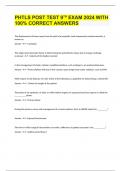
-
PHTLS POST TEST 9TH EXAM 2024 WITH 100% CORRECT ANSWERS
- Exam (elaborations) • 10 pages • 2024
-
Available in package deal
-
- $16.49
- + learn more
The displacement of tissue away from the path of a projectile, both temporarily and permanently, is known as: Answer - Cavitation The single most important factor in determining the potential for injury due to energy exchange is:Answer - Velocity of the bodies involved In the management of shock, isotonic crystalloid solutions, such as Ringer's, are preferred because: Answer - These solutions will stay in the vascular space longer than water solutions, such as D5W With respect t...
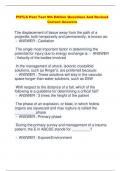
-
PHTLS Post Test 9th Edition Questions And Revised Correct Answers
- Exam (elaborations) • 13 pages • 2024
-
Available in package deal
-
- $9.99
- + learn more
PHTLS Post Test 9th Edition Questions And Revised Correct Answers The displacement of tissue away from the path of a projectile, both temporarily and permanently, is known as: - ANSWER : Cavitation The single most important factor in determining the potential for injury due to energy exchange is: - ANSWER : Velocity of the bodies involved In the management of shock, isotonic crystalloid solutions, such as Ringer's, are preferred because: - ANSWER : These solutions will stay in ...
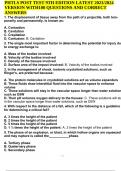
-
PHTLS POST TEST 9TH EDITION LATEST 2023/2024 VERSION WITH100 QUESTIONS AND CORRECT ANSWERS.
- Exam (elaborations) • 17 pages • 2023
-
- $11.99
- + learn more
PHTLS POST TEST 9TH EDITION LATEST 2023/2024 VERSION WITH100 QUESTIONS AND CORRECT ANSWERS. 1. The displacement of tissue away from the path of a projectile, both temporarily and permanently, is known as: A. Conization B. Cavitation C. Crepitation D. Contusion: B. Cavitation 2. The single most important factor in determining the potential for injury due to energy exchange is: A. Mass of the bodies involved B. Velocity of the bodies involved C. Density of the tissues involved D. Surfac...
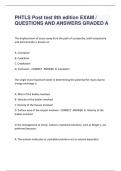
-
PHTLS Post test 9th edition EXAM / QUESTIONS AND ANSWERS GRADED A
- Exam (elaborations) • 26 pages • 2023
-
- $13.49
- + learn more
PHTLS Post test 9th edition EXAM / QUESTIONS AND ANSWERS GRADED A The displacement of tissue away from the path of a projectile, both temporarily and permanently, is known as: A. Conization B. Cavitation C. Crepitation D. Contusion - CORRECT ANSWER B. Cavitation The single most important factor in determining the potential for injury due to energy exchange is: A. Mass of the bodies involved B. Velocity of the bodies involved C. Density of the tissues involved D. Surface a...
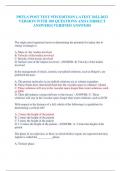
-
PHTLS POST TEST 9TH EDITION LATEST VERSION WITH 100 QUESTIONS AND CORRECT ANSWERS| VERIFIED ANSWERS
- Exam (elaborations) • 22 pages • 2024
-
- $17.99
- + learn more
PHTLS POST TEST 9TH EDITION LATEST VERSION WITH 100 QUESTIONS AND CORRECT ANSWERS| VERIFIED ANSWERS. The single most important factor in determining the potential for injury due to energy exchange is: A. Mass of the bodies involved B. Velocity of the bodies involved C. Density of the tissues involved D. Surface area of the impact involved - ANSWER- B. Velocity of the bodies involved In the management of shock, isotonic crystalloid solutions, such as Ringer's, are preferred because: A. The prote...
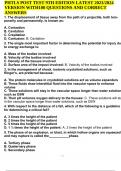
-
PHTLS POST TEST 9TH EDITION LATEST 2023/2024 VERSION WITH100 QUESTIONS AND CORRECT ANSWERS.
- Exam (elaborations) • 17 pages • 2023
-
- $11.99
- + learn more
PHTLS POST TEST 9TH EDITION LATEST 2023/2024 VERSION WITH100 QUESTIONS AND CORRECT ANSWERS. 1. The displacement of tissue away from the path of a projectile, both temporarily and permanently, is known as: A. Conization B. Cavitation C. Crepitation D. Contusion: B. Cavitation 2. The single most important factor in determining the potential for injury due to energy exchange is: A. Mass of the bodies involved B. Velocity of the bodies involved C. Density of the tissues involved D. Surfac...

-
PHTLS Pre & Post Test 9TH EDITION 2022/2023
- Exam (elaborations) • 20 pages • 2022
- Available in package deal
-
- $11.49
- 2x sold
- + learn more
PHTLS Pre & Post Test 9TH EDITION 2022/2023
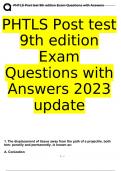
-
PHTLS Post test 9th edition Exam Questions with Answers 2023 update
- Exam (elaborations) • 24 pages • 2023
-
- $10.99
- + learn more
PHTLS Post test 9th edition Exam Questions with Answers 2023 update PHTLS Post test 9th edition Exam Questions with Answers 2023 update 1. The displacement of tissue away from the path of a projectile, both tem- porarily and permanently, is known as: A. Conization B. Cavitation C. Crepitation D. Contusion: B. Cavitation 2. The single most important factor in determining the potential for injury due to energy exchange is: A. Mass of the bodies involved B. Velocity of...
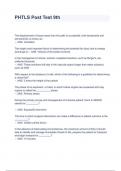
-
PHTLS Post Test 9th Questions And Answers
- Exam (elaborations) • 8 pages • 2023 Popular
-
- $8.49
- 1x sold
- + learn more
PHTLS Post Test 9th Questions And Answers The displacement of tissue away from the path of a projectile, both temporarily and permanently, is known as: - ANS Cavitation The single most important factor in determining the potential for injury due to energy exchange is: - ANS Velocity of the bodies involved In the management of shock, isotonic crystalloid solutions, such as Ringer's, are preferred because: - ANS These solutions will stay in the vascular space longer ...

-
PHTLS Post Test 9th Edition (Latest 2023/ 2024) Questions and Verified Answers| Grade A
- Exam (elaborations) • 24 pages • 2023
-
Available in package deal
-
- $10.99
- + learn more
PHTLS Post Test 9th Edition (Latest 2023/ 2024) Questions and Verified Answers| Grade A Q: Which of the following represents adequate spontaneous ventilation in an adult? A. Tidal volume 100 mL, ventilatory rate 40/minute B. Tidal volume 500 mL, ventilatory rate 8/minute C. Tidal volume 300 mL, ventilatory rate 16/minute D. Tidal volume 600 mL, ventilatory rate 12/minute Answer: D. Tidal volume 600 mL, ventilatory rate 12/minute Q: Which of the following is 100% accurat...

Study stress? For sellers on Stuvia, these are actually golden times. KA-CHING! Earn from your study resources too and start uploading now. Discover all about earning on Stuvia


